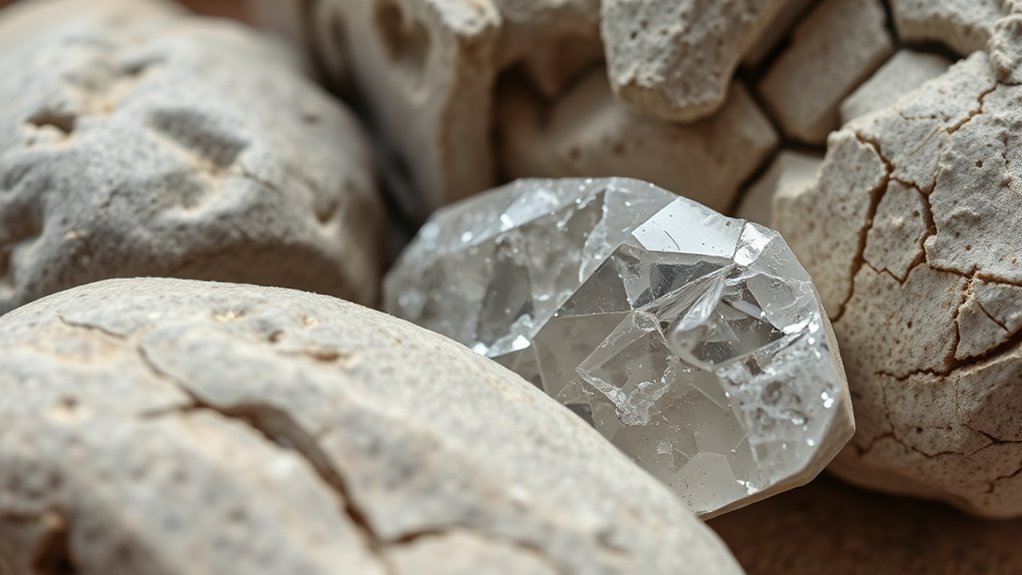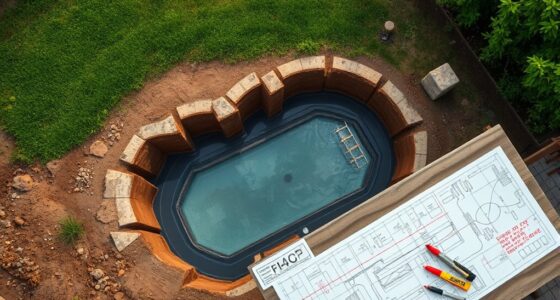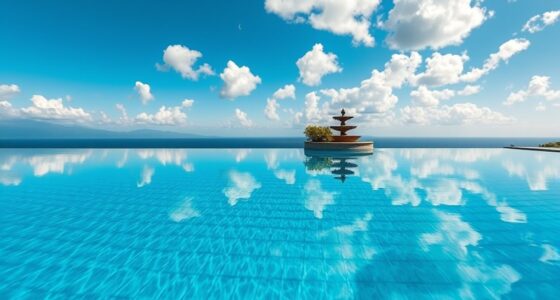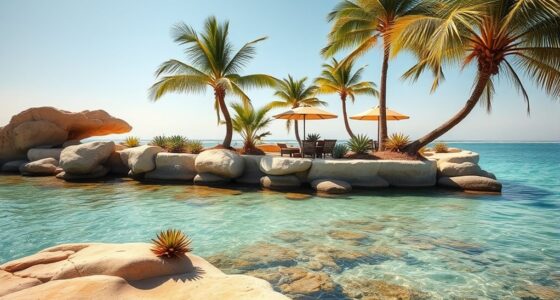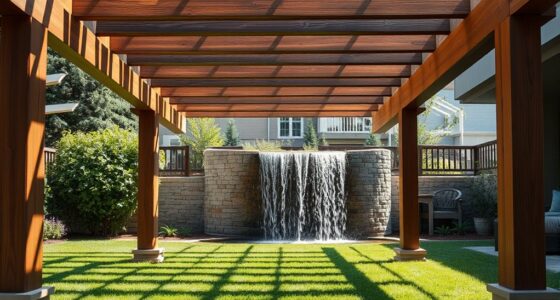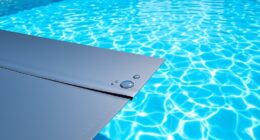Over time, pebble finishes develop a rustic charm with subtle smoothing, shifting stones, and weathered textures, but they can loosen or crack with exposure to water and UV rays. Quartz surfaces keep their vibrant appearance longer, resisting stains and weathering, though minor scratches may occur. Plaster tends to become uneven, develop cracks, and fade in color, especially outdoors. Understanding how each finish ages helps you choose the right option for long-term durability—more details await as you continue.
Key Takeaways
- Pebble finishes develop a rustic, weathered look with natural smoothing and shifting of stones, showing signs of wear over time.
- Quartz surfaces retain their color and shine longer, with minimal fading and better resistance to environmental damage.
- Plaster finishes become rougher, develop microcracks, and fade or discolor as they age, especially when exposed to harsh weather.
- Pebble surfaces are more vulnerable to water infiltration and surface fractures, requiring regular maintenance to prolong lifespan.
- Quartz is highly durable outdoors, resisting stains and moisture, while plaster needs protective coatings to prevent rapid deterioration.
The Natural Wear and Tear of Pebble Finishes
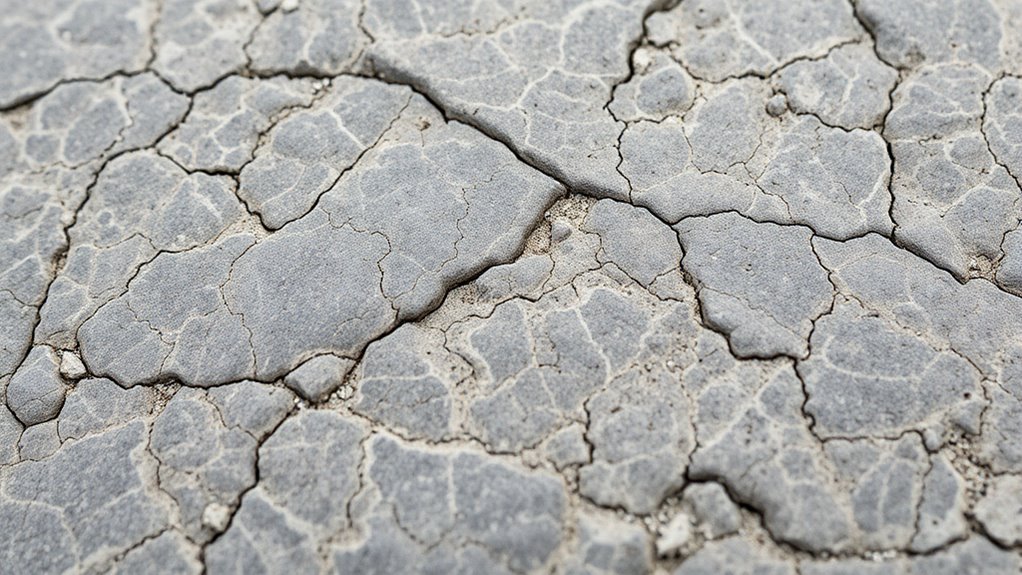
Over time, pebble finishes naturally develop signs of wear that add character to their appearance. You might notice small scratches or subtle smoothing in high-traffic areas, which tell the story of daily use. The textured surface can become slightly softer, creating a more comfortable feel underfoot or when touched. As the natural stones shift and settle, some unevenness may occur, giving the finish a more authentic and rustic look. Exposure to weather, foot traffic, or cleaning practices can accelerate this process, but it generally enhances the charm rather than detracts from it. Pebble finishes are resilient, and their gradual aging often highlights their natural beauty, making them a timeless choice for outdoor patios, walkways, or feature walls. Additionally, Hyundai Tuning options can be customized to enhance the durability and aesthetic appeal of surfaces in various environments.
How Quartz Surfaces Maintain Their Shine Over the Years
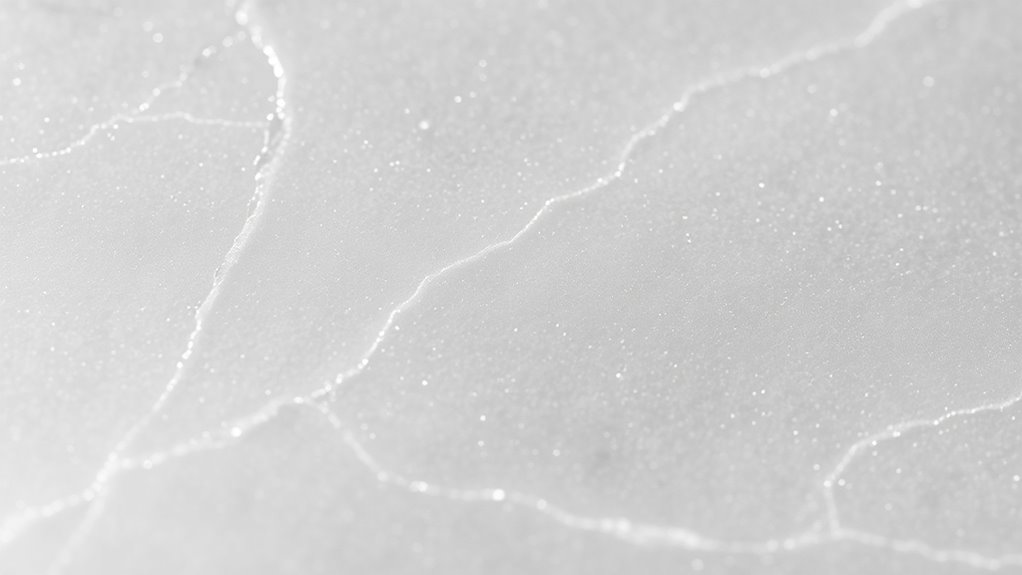
Quartz surfaces stay shiny because they resist stains, keeping their look intact over time. Their rich color stays vibrant, even with regular use, thanks to excellent color retention. Plus, they’re easy to clean and maintain, helping you preserve that beautiful shine effortlessly. Regular cleaning and proper surface maintenance prevent damage and keep the finish looking new for years.
Resistant to Stains
Because of their non-porous nature, quartz surfaces resist stains more effectively than many other materials. This means liquids like wine, coffee, or oil won’t seep in and cause permanent marks. You won’t need to worry about accidental spills ruining your surface or needing harsh cleaning agents to remove stains. Quartz’s smooth surface makes it easy to wipe clean, preventing dirt and grime buildup. Over time, this resistance helps your countertop maintain its fresh, polished appearance without discoloration or spots. Unlike porous materials, quartz doesn’t require sealing or special treatments to stay stain-free. This durability ensures your surface remains beautiful and functional, even with regular use. Additionally, the long-lasting nature of quartz contributes to its ability to withstand daily wear and tear, keeping it looking new for years to come. In short, quartz’s stain resistance keeps your surface looking new for years to come.
Color Retention Over Time
Thanks to their non-porous surface, quartz countertops resist stains and are easy to keep looking new. Their color retention over time remains impressive, thanks to the engineered pigments integrated during manufacturing. Unlike natural materials that fade or change shade, quartz maintains its vibrant hue for years. Environmental factors like sunlight and heat have minimal impact on its color stability. To illustrate, consider the following:
| Factor | Effect on Color Retention |
|---|---|
| UV Exposure | Can cause slight fading |
| Cleaning Products | Should be non-abrasive to prevent dulling |
| Daily Use | Minimal impact if properly maintained |
| Age | Colors stay consistent over time |
| Surface Treatments | May enhance longevity of color |
Additionally, proper calibration of your surfaces can further preserve their appearance over time. Proper care guarantees your quartz surface retains its shine and color, making it a lasting choice.
Easy Maintenance and Care
Maintaining the natural shine of quartz surfaces is straightforward, even with regular use. With simple care, your quartz can stay vibrant and polished for years. Regular cleaning with mild soap and water removes daily grime without damaging the surface. Avoid harsh chemicals or abrasive scrubbers that can dull the finish. To preserve its luster, wipe up spills immediately, especially acidic substances like lemon or vinegar. Periodic use of a non-abrasive quartz cleaner can help restore shine. Additionally, choosing the right surface finish during installation can influence how well the surface ages over time.
The Aging Process of Plaster and Its Visual Changes

As plaster ages, you’ll notice surface textures becoming less smooth and more uneven over time. Colors also fade or change, giving the surface a different visual appeal. Understanding these changes helps you anticipate how your finishes will evolve. Additionally, the surface may develop wear and tear, impacting its overall appearance and integrity.
Surface Texture Changes
Have you ever noticed how plaster surfaces develop subtle changes in texture over time? As the material ages, you’ll see a softening or slight roughening, often creating a more tactile surface. These changes result from ongoing shrinkage, weathering, and minor surface degradation. Over years, the once smooth or finely textured finish can become more irregular, with tiny pits or ridges forming. This process adds character, but also alters the original surface feel. To understand this transformation, consider these points:
- Surface erosion from environmental exposure
- Development of microcracks affecting texture continuity
- Accumulation of dirt and deposits altering tactile qualities
- The natural breakdown of surface binders over time
- Surface aging is influenced by both environmental factors and the inherent properties of the materials used.
These factors contribute to a richer, more complex surface that tells the story of its age.
Color Fading Effects
Over time, the color of plaster surfaces gradually fades, revealing signs of aging that can alter the building’s visual appeal. Sun exposure, pollution, and weathering accelerate this process, causing the original hue to dull or shift. You might notice the once vibrant surface becoming more muted, with uneven patches or discoloration developing over years. Light colors tend to fade more noticeably, while darker tones may retain some depth but still lose their richness. This color change can give your structure a weathered, historic feel or suggest neglect if unmaintained. While fading is natural, it can also be managed through regular cleaning, protective coatings, or repainting to restore the original appearance. Understanding this process helps you decide whether to embrace or counteract the fading effects. Additionally, awareness of surface aging can guide you in selecting appropriate surface finishes that better withstand environmental exposure over time.
Resistance to Environmental Factors: Pebble Versus Quartz and Plaster

When evaluating surface finishes for durability, understanding their resistance to environmental factors is essential. Pebble finishes tend to be more vulnerable to water infiltration and UV damage, which can cause surface erosion over time. Quartz finishes, with their dense composition, resist moisture and staining better, making them suitable for outdoor use. Plaster, while easy to repair, can degrade quickly when exposed to harsh weather or temperature fluctuations.
Pebble finishes are more vulnerable to water and UV damage, while quartz resists moisture and stains well.
Consider these factors:
- Water resistance and absorption rates
- UV light durability
- Impact and abrasion resistance
- Resistance to mold and mildew growth
Cracking and Chipping: What Happens to Each Finish Over Time
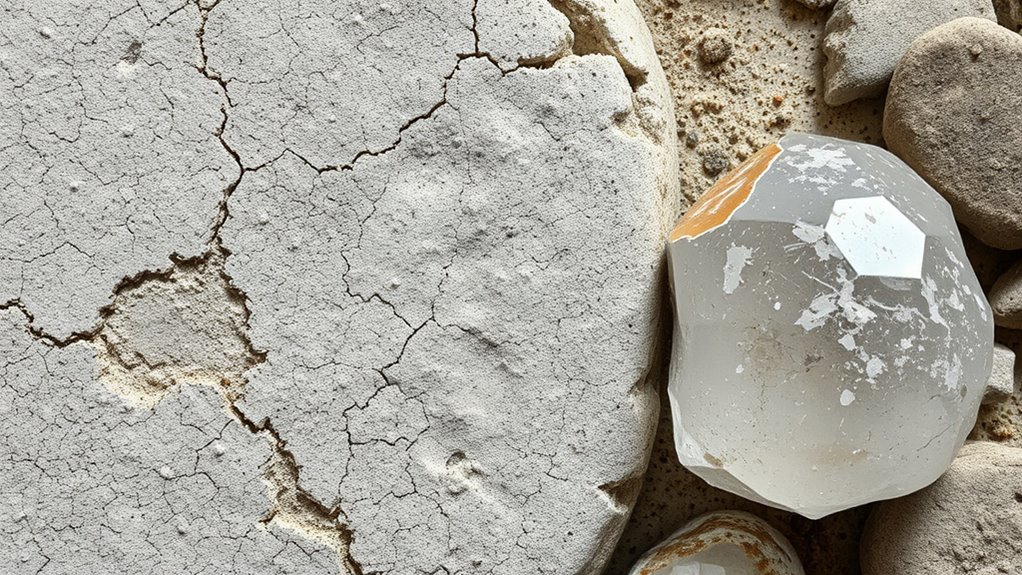
Over time, you’ll notice different finishes develop cracks or chips, affecting their surface durability. Some materials are more prone to specific damage patterns, which can weaken their appearance and function. Understanding these common issues helps you choose the right finish to minimize long-term wear. Additionally, considering the typical material lifespan can guide you in selecting finishes that best withstand outdoor conditions over many years.
Surface Durability Concerns
Surface finishes are vulnerable to cracking and chipping as they age, which can compromise both appearance and protection. Over time, each type reacts differently to wear and environmental stress. Pebble surfaces may develop loose stones or surface fractures, weakening their integrity. Quartz finishes are prone to surface scratches and small chips, especially in high-traffic areas. Plaster can crack due to settling or temperature fluctuations, leading to visible lines and potential deterioration. To maintain durability, regular inspections and timely repairs are essential. Understanding these vulnerabilities helps you choose appropriate maintenance strategies and extend the lifespan of your surface finishes.
- Pebble: Loose stones and surface fractures
- Quartz: Surface scratches and chips
- Plaster: Cracks from settling or temperature shifts
- All finishes: Wear from continuous use and environmental exposure
Common Damage Patterns
As surface finishes age, cracks and chips become common signs of deterioration, each pattern revealing how different materials respond to environmental stresses and wear. Pebble finishes often develop hairline cracks due to settling or temperature changes, but they usually resist chipping unless impacted strongly. Quartz surfaces are more prone to chipping at edges or corners if struck, as their hard composition can fracture under force. Plaster finishes tend to crack more readily over time, especially if not properly maintained, and chips often occur around high-traffic areas or where impact happens. Recognizing these patterns helps you identify which finish might need repair or replacement. Understanding each material’s vulnerabilities allows you to plan maintenance and prolong the lifespan of your surfaces effectively. Additionally, material durability plays a crucial role in how these finishes age under various environmental conditions.
Color Fading and Discoloration in Different Surface Materials

Color fading and discoloration are common issues affecting various surface materials as they age. Over time, exposure to sunlight, pollution, and chemical reactions can alter their appearance. You might notice quartz surfaces losing their vibrant hue, plaster developing uneven tones, or pebble finishes dulling in color. Understanding these changes helps you anticipate maintenance needs and choose appropriate treatments.
- UV exposure accelerates fading in lighter tones
- Chemical reactions cause staining or yellowing
- Porous materials absorb stains more easily
- Protective sealants can slow discoloration progression
The Effect of Weather Conditions on Outdoor Finishes
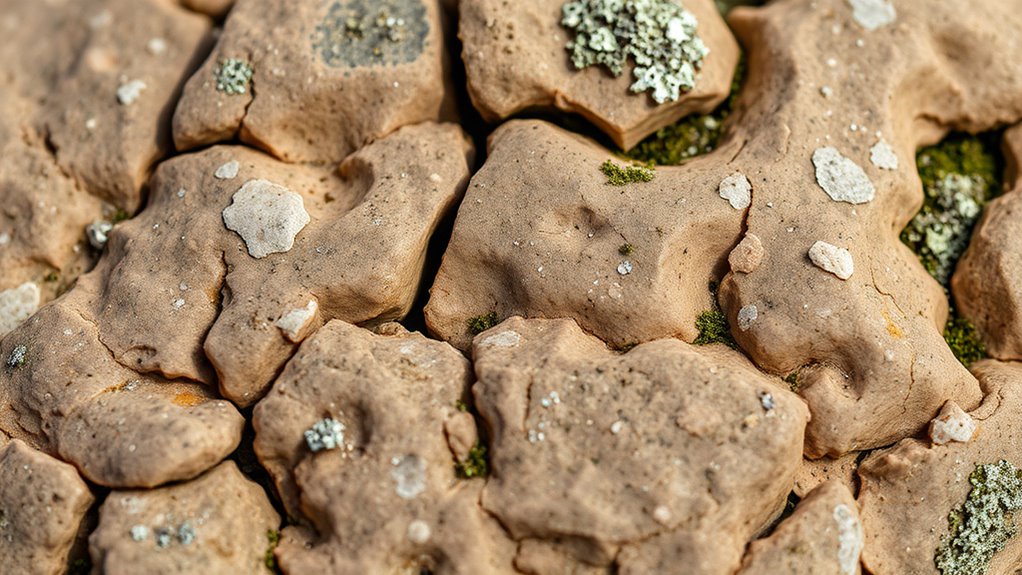
Weather conditions can markedly impact outdoor finishes, causing them to deteriorate over time. Exposure to sun, rain, snow, and wind accelerates wear and tear on surfaces. UV rays from sunlight break down pigments and weaken finishes, leading to fading and loss of vibrancy. Moisture from rain or snow can cause swelling, cracking, or peeling, especially if finishes aren’t properly sealed. Temperature fluctuations create expansion and contraction, which can crack or delaminate coatings. Wind carries debris and pollutants that abrade surfaces, further damaging the finish. Over time, these elements cause finishes to fade, discolor, and lose their protective qualities. To preserve outdoor finishes longer, it’s essential to understand how weather interacts with your surface materials and to implement suitable protective measures.
Maintenance Needs and Their Impact on Longevity

Have you considered how regular maintenance can substantially extend the life of your outdoor finishes? Consistent upkeep prevents minor issues from escalating, preserving the surface’s appearance and structural integrity. Neglecting maintenance accelerates wear, leading to costly repairs or replacements. To maximize longevity, focus on essential tasks like cleaning, sealing, and inspecting for damage.
Regular maintenance preserves outdoor finishes, preventing damage and costly repairs.
Key maintenance practices include:
- Regularly cleaning surfaces to remove dirt and prevent staining
- Applying protective sealants to resist moisture and weathering
- Addressing cracks or chips promptly before they worsen
- Using appropriate cleaning agents to avoid surface deterioration
Implementing these steps helps your finishes withstand weather and aging, keeping them looking fresh longer and reducing long-term expenses. Proper maintenance isn’t just routine; it’s an investment in durability.
Repairing and Restoring Aged Pebble, Quartz, and Plaster Surfaces
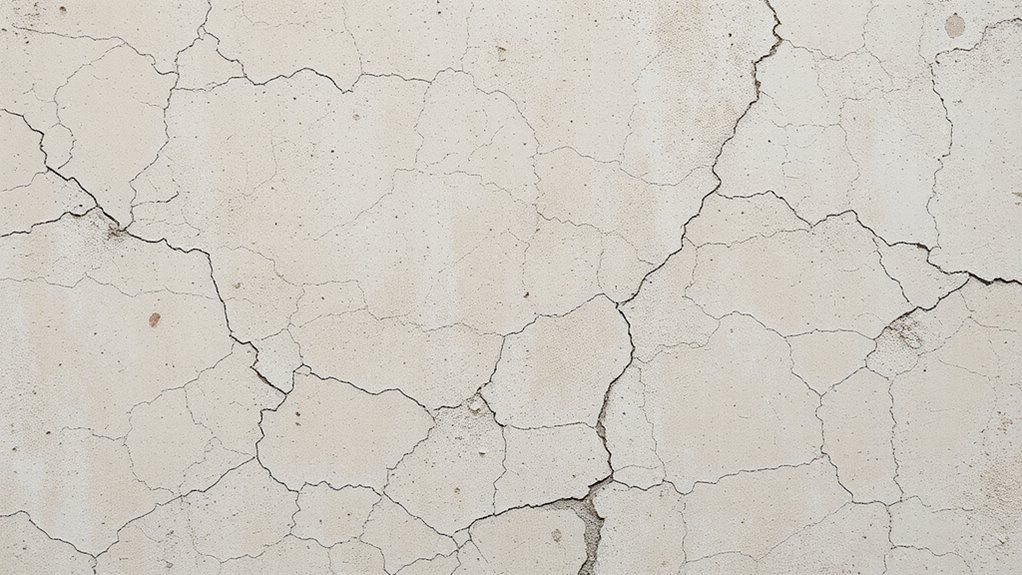
When surfaces like pebble, quartz, and plaster begin to show signs of aging, timely repairs and restoration can make a significant difference in extending their lifespan. You can restore their beauty by addressing cracks, chips, and discoloration early. Start by cleaning the surface thoroughly, then assess damage. For minor issues, use patching compounds matching the original finish. Severe damage might require removing and reapplying the surface. Proper tools and materials are essential for a seamless fix.
| Surface Type | Common Damage | Restoration Tip |
|---|---|---|
| Pebble | Cracks, chips | Fill with matching mortar |
| Quartz | Fading, scratches | Re-polish or reseal |
| Plaster | Cracks, stains | Reapply or patch |
| Pebble | Discoloration | Clean and reseal |
| Quartz | Surface wear | Light sanding and sealing |
Long-Term Cost Considerations for Different Finish Types

Choosing the right surface finish involves considering not just initial costs but also long-term expenses. Pebble, quartz, and plaster each have distinct maintenance needs and durability levels that impact your budget over time. Pebble finishes may require periodic resealing or repairs due to chipping or wear. Quartz surfaces tend to be more durable but can be costly to repair if damaged. Plaster finishes are often more affordable initially but can crack or degrade, leading to ongoing restoration costs. When evaluating long-term costs, think about:
- Frequency of repairs and maintenance
- Longevity and resistance to wear
- Cost of professional restoration
- Impact on property value over time
Understanding these factors helps you make an informed, cost-effective choice tailored to your needs and budget.
Frequently Asked Questions
How Do Surface Finishes Affect Property Value Over Time?
Surface finishes considerably impact your property’s value over time. A high-quality finish maintains its appearance longer, boosting curb appeal and market desirability. However, lower-grade finishes can degrade, crack, or discolor, making your property seem less maintained and reducing its value. Regular upkeep and choosing durable finishes help preserve your home’s appeal, ensuring it stays attractive and competitive in the market as it ages.
Are There Eco-Friendly Options for Maintaining These Finishes?
Yes, there are eco-friendly options for maintaining surface finishes. You can use natural cleaning solutions like vinegar and water or biodegradable sealants that protect without harmful chemicals. Regular gentle cleaning helps prevent deterioration, and choosing environmentally safe products extends the lifespan of your finishes. By avoiding harsh chemicals, you preserve the integrity of your surfaces while reducing your ecological footprint, ensuring they stay beautiful and sustainable over time.
Can Surface Finishes Be Customized to Match Evolving Interior Trends?
Did you know that 78% of interior designers say customizing finishes keeps spaces fresh and stylish? You can absolutely personalize surface finishes to match evolving trends. By choosing versatile colors, textures, and techniques, you can update your surfaces without complete replacements. Regular updates, like new paint layers or subtle accents, allow your finishes to stay current and vibrant, reflecting your evolving style while maintaining durability over time.
What Is the Best Way to Prevent Surface Finish Deterioration?
To prevent surface finish deterioration, you should regularly clean and seal the surface, avoiding harsh chemicals that can cause damage. Use gentle cleaning agents and reseal as recommended by manufacturers. Protect the finish from excessive moisture, UV exposure, and heavy impacts. Consistent maintenance extends the lifespan of your surface and keeps it looking fresh. Taking these steps ensures your finish stays durable and attractive over time.
How Do Different Finishes Impact Indoor Air Quality Long-Term?
Your choice of finish impacts indoor air quality over time. Some finishes release volatile organic compounds (VOCs), which can cause health issues if they accumulate. For example, certain paints and sealants emit VOCs initially but decrease with ventilation. Opt for low-VOC or VOC-free finishes to maintain healthier air quality long-term. Regular cleaning and proper ventilation also help reduce any residual emissions, ensuring a safer indoor environment for you and your family.
Conclusion
As your surfaces age, the choice between pebble, quartz, or plaster becomes even more vital. Will the vibrant pebble withstand the test of time, or will the sleek quartz maintain its shine? Or perhaps the charming imperfections of aged plaster tell a different story? Your decision shapes the future look and feel of your space—but the real surprise lies in how these finishes will weather the years ahead. Are you ready to face what’s to come?
